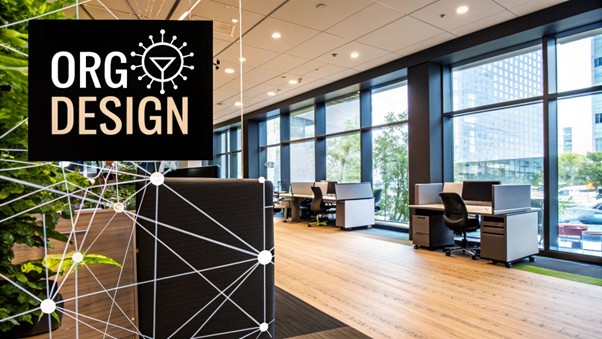The Foundations of Effective Organizational Design

Building a successful organization requires a solid foundation. That foundation is organizational design. This involves strategically structuring the organization to achieve its goals. It’s more than just creating an org chart; it’s about aligning people, processes, and technology. Think of it like constructing a building: you wouldn’t start without a blueprint. Similarly, organizational design provides the blueprint for your business operations.
Key Principles of Organizational Design
Several core principles guide effective organizational design. When applied thoughtfully, these principles can help businesses, especially in the IN region, succeed in today’s competitive market. For context, consider the traits of high performance organizations.
- Alignment: This principle emphasizes aligning the organizational structure with the overall strategy. Every team, department, and individual should understand how their work contributes to the larger business objectives. This creates focus and drives everyone towards a common goal.
- Clarity: Clear roles and responsibilities are essential for effective execution. Each employee should understand their duties, reporting structure, and decision-making authority. This clarity minimizes confusion, improves communication, and promotes accountability.
- Flexibility: In a dynamic business environment, organizations need to be adaptable. A flexible design allows the company to quickly adjust to market shifts, new technologies, and evolving customer needs.
- Scalability: As businesses grow, their organizational design must scale accordingly. A scalable design accommodates expansion without disrupting core operations or affecting efficiency. This is especially important for rapidly growing companies in the IN region.
The Impact of Structure on Organizational Performance
Understanding the impact of different structures is crucial in organizational design. The Functional Structure, where employees are grouped by specialization, is often used for its efficiency. However, in regions like India (part of the larger South Asia or ‘IN’ region), companies often blend functional and divisional structures to address diverse product lines and geographic markets. Business studies on organizational design principles suggest about 70% of companies globally use functional structures. This can vary in the IN region due to differing market demands and operational needs. Even without specific IN region data, the trend points towards more agile and flexible structures, mirroring global trends, to adapt to changing business environments. Learn more here.
These core principles, applied within the IN region’s unique business landscape, build a strong foundation for organizational success. Focusing on alignment, clarity, flexibility, and scalability allows businesses to create structures that support their strategic ambitions and enable them to thrive in a dynamic market. The interplay between organizational design and the specific needs of the business environment is key.
Creating Perfect Alignment Between Structure and Strategy
Aligning your organizational design with your strategy is essential for success. Think of it like planning a road trip: you need a map and a clear destination. Your organizational structure serves as that roadmap, guiding your team towards your strategic goals. This alignment keeps everyone moving in the same direction, maximizing efficiency and minimizing wasted effort, a particularly important factor in the dynamic IN region market.
Defining Strategic Alignment
Strategic alignment in organizational design means structuring your company to directly support the execution of your strategic goals. For instance, if your strategy focuses on innovation leadership, your structure should empower teams to experiment and develop new ideas. This could involve cross-functional teams or dedicated innovation hubs. Conversely, if operational efficiency is your primary goal, a more hierarchical structure with clear lines of authority might be more suitable.
This alignment fosters a sense of purpose and direction. When employees understand how their role contributes to the overall strategy, they are more engaged and productive. It also enables better resource allocation, ensuring investments in personnel, technology, and processes are directed towards achieving strategic objectives.
Recognizing Misalignment
Misalignment often manifests as friction and inefficiency. For example, teams constantly battling for resources or slow, cumbersome decision-making processes can signal a structural-strategic mismatch. Other symptoms include duplicated efforts, missed deadlines, and unclear roles and responsibilities.
Aligning organizational design with strategy is paramount. In the IN region, especially India, companies face complex market conditions demanding organizational agility and strategic alignment. A Boston Consulting Group (BCG) study highlighted how organizational performance is directly linked to individual behaviors, shaped by the organizational context. While specific IN region statistics are limited, globally, companies aligning structure with strategy typically see performance improvements of 10% to 30%, depending on the sector and execution. This underscores the importance of prioritizing this alignment for IN region companies. Learn more about the connection between organizational design and performance.
Achieving and Maintaining Alignment
Creating and maintaining this vital alignment is an ongoing process of evaluation and adjustment. Regularly review your organizational structure against your evolving strategic priorities. As market conditions change or new opportunities arise, adapt your structure to support your goals. This may involve restructuring teams, redefining roles, or adjusting reporting lines. The key is to remain flexible and responsive to the changing business landscape while staying focused on your strategic objectives. This proactive approach to organizational design positions your company for continued success in the competitive IN region market.
Mastering Role Clarity and Accountability Systems

Workplace ambiguity can significantly impact productivity. This section explores the essential elements of establishing clear roles and robust accountability systems within your organization. This is particularly relevant in the IN region, where maximizing the potential of a skilled workforce is key.
Defining Clear Roles and Responsibilities
Clearly defined roles are fundamental to a successful organization. They provide employees with a strong understanding of their duties and their contributions to overall objectives. This clarity minimizes confusion, streamlines workflows, and cultivates a sense of ownership.
Clear roles also facilitate better resource allocation and ensure everyone works towards shared goals. For example, a marketing team with defined roles for content creation, social media management, and campaign analysis operates more efficiently than a team with overlapping, poorly defined responsibilities.
Additionally, clear roles establish a framework for professional development. Employees can identify skill gaps and pursue growth opportunities aligned with their responsibilities. This focus on individual growth contributes to overall organizational success, especially important in the competitive IN region business environment.
Establishing Effective Accountability Systems
Accountability isn’t about assigning blame; it’s about ownership and responsibility. When employees understand their roles and are held accountable for their performance, they become more engaged and produce higher-quality work.
Effective accountability systems involve setting clear expectations, providing regular feedback, and recognizing achievements and areas for improvement. This creates a culture where accountability empowers rather than punishes.
This is particularly relevant in the IN region, where strong interpersonal relationships and a sense of community are valued in the workplace. Accountability systems aligned with these cultural values can drive positive outcomes.
To understand how to implement these concepts effectively, let’s look at the following framework:
Introduction to the Role Clarity Implementation Framework: The following table offers a practical guide for implementing role clarity and accountability across different organizational levels. It highlights key responsibilities, accountability mechanisms, and potential pitfalls.
| Organizational Level | Key Responsibility Areas | Accountability Mechanisms | Common Pitfalls |
| Individual Contributor | Task completion, meeting deadlines, adhering to quality standards | Performance reviews, self-assessment, regular feedback from managers | Lack of clarity on expectations, insufficient resources, inadequate training |
| Team Leader | Delegating tasks, monitoring team performance, resolving conflicts, reporting progress | Team meetings, project reports, performance dashboards, 360-degree feedback | Micromanagement, inconsistent communication, unclear team goals |
| Department Head | Setting departmental goals, resource allocation, performance management, strategic planning | Department-level reviews, budget reports, key performance indicators (KPIs) | Lack of cross-functional collaboration, siloed thinking, ineffective delegation |
| Executive Leadership | Setting organizational vision and strategy, overseeing operations, ensuring compliance, stakeholder management | Board meetings, annual reports, external audits, investor relations | Lack of transparency, disconnect from ground-level realities, resistance to change |
Key Insights from the Role Clarity Implementation Framework: This framework provides a starting point for organizations to tailor their approach to role clarity based on their specific needs and context. By addressing the common pitfalls, organizations can foster a culture of accountability and empower employees to achieve their full potential.
In terms of organizational design, clear roles and responsibilities and employee empowerment are crucial for success. In regions like India with abundant skilled human capital, optimizing these elements can lead to significant productivity gains. However, a gap exists between best practices and implementation. While about 80% of businesses globally recognize the importance of clear roles, only about 40% implement effective role definitions consistently. In the IN region, similar challenges exist, but there’s a growing trend towards adopting more participative management styles to enhance employee motivation and productivity. Explore organizational design principles further here.
Balancing Specialization and Collaboration
While specialized expertise is essential, organizations must also foster cross-functional collaboration. Clear roles shouldn’t create rigid silos. Effective organizational design promotes collaboration by defining clear interfaces between roles and establishing mechanisms for communication and knowledge sharing.
This balance between specialization and collaboration is crucial in the IN region’s diverse business landscape. It allows organizations to leverage specialized skills while promoting teamwork and communication, which are essential for success in a dynamic market. Building this collaborative spirit, while respecting cultural contexts, is key for consistent results across diverse teams.
Transforming Through Agile Organizational Design Principles

Traditional, hierarchical organizational structures are proving less effective in today’s rapidly changing business environment. This is driving a significant shift towards adaptable and responsive models, especially in the IN region, where market dynamics are in constant flux. These newer models prioritize agile organizational design principles, emphasizing flexibility, collaboration, and rapid iteration. Let’s explore how leading companies are using these principles to achieve remarkable results.
Embracing Agile Principles in Organizational Design
Agile methodologies, initially prevalent in software development, are now successfully applied to organizational design. This involves transitioning from rigid hierarchies to more flexible, self-managing teams. The ‘Agile à la Spotify’ model, which emphasizes autonomy and cross-functional collaboration, has gained considerable popularity.
This shift towards agile principles allows organizations to respond faster to changing market demands and accelerate the pace of innovation. It empowers teams to experiment, learn, and adapt quickly, fostering a culture of continuous improvement. This is especially relevant in the IN region, where businesses encounter unique market challenges and opportunities.
Agile organizational design requires a different leadership approach. Instead of top-down directives, agile organizations favor shared leadership and distributed decision-making. This cultivates a sense of ownership and empowers employees at all levels to contribute meaningfully to organizational success. This is particularly crucial for businesses in the IN region, where employee engagement is key to retention.
Implementing Agile Frameworks in Traditional Environments
Transitioning to an agile organizational design has its difficulties. Many established organizations in the IN region operate within traditional hierarchical structures. Implementing agile frameworks in these environments requires careful planning and execution. This often involves addressing resistance to change, developing new skill sets, and redefining existing roles.
Some teams may find it challenging to adapt to self-management, and require training and support to develop the necessary skills. Integrating agile methodologies into existing processes can also be complex, and may require significant adjustments to workflows. However, the benefits of increased agility and responsiveness typically outweigh these initial challenges.
Organizational design has evolved to incorporate more agile methodologies, such as the ‘Agile à la Spotify’ approach, which prioritizes autonomy and flexible team structures. This model has been influential globally, including in regions like India, where innovation and rapid response to market changes are vital. While specific IN region data on the adoption of these models is limited, a survey by a leading consulting firm found that roughly 60% of Indian businesses have begun implementing agile practices in some capacity to improve innovation and speed. This shift reflects a broader move toward flatter organizational structures designed for adaptability in dynamic market conditions and technological advancements. Learn more here.
Measuring the Impact of Agile Transformation
Measuring the impact of agile organizational design is crucial for ensuring alignment with business objectives. Key metrics include team velocity, cycle time, and customer satisfaction. Assessing employee engagement and morale provides further insights into the human element of this transformation.
This data is instrumental in refining the implementation strategy and demonstrating the value of the agile approach to stakeholders. By tracking these metrics, businesses in the IN region can quantify the benefits of their agile transformation and pinpoint areas for ongoing improvement. Agile organizational design ultimately enables companies to become more resilient, adaptive, and responsive to the constantly evolving business environment. This prepares them for sustained success in the dynamic IN region market and beyond.
Finding Your Perfect Centralization-Decentralization Balance

One of the most complex decisions for any organization is finding the right balance between centralized control and decentralized autonomy. This balance significantly impacts a company’s agility, responsiveness, and overall efficiency. For businesses in the IN region, navigating diverse markets and operational complexities makes finding this balance especially crucial for long-term success.
Centralization vs. Decentralization: Understanding the Trade-offs
Centralization concentrates decision-making authority at the top of the organizational chart. This approach promotes consistency and standardized processes, often beneficial for departments like finance and legal.
However, too much centralization can stifle innovation and create bottlenecks. This can hinder rapid responses to market changes, a critical factor for businesses in the IN region.
Decentralization, on the other hand, distributes decision-making power across various levels and departments. This fosters empowerment, local responsiveness, and faster decision-making on the ground. This is particularly valuable in the IN region’s dynamic business environment.
Decentralization is often preferred for functions like sales and marketing, allowing teams to tailor strategies to local market conditions. However, if not implemented thoughtfully, it can lead to inconsistencies and a lack of overall strategic alignment.
Evaluating Your Needs: Factors Influencing the Balance
The ideal centralization-decentralization balance isn’t universal. It depends on several factors unique to each organization:
- Organizational Size: Larger organizations often lean towards decentralization to manage their inherent complexity and empower local teams. This is especially relevant for large companies working across multiple states within the IN region.
- Industry: Highly regulated industries, like finance or healthcare, often favor centralization for compliance and consistency. Rapidly evolving sectors, like technology, often benefit from the agility of decentralization. The diverse industries within the IN region necessitate that organizations consider their specific sector.
- Culture: Organizations that value collaboration and employee empowerment often favor decentralization. Those prioritizing control and efficiency might prefer a more centralized structure. Cultural nuances within the IN region can significantly impact this choice.
- Strategic Goals: If innovation is a key priority, decentralization can empower teams to experiment and adapt. If cost efficiency is paramount, centralization might offer the opportunity to streamline processes. Aligning organizational design principles with specific strategic goals is critical for IN region businesses.
Implementing Hybrid Approaches: Combining the Best of Both Worlds
Many successful organizations adopt hybrid models, combining elements of both centralization and decentralization. This approach allows for tailoring the balance to specific functions and situations.
For example, a company might centralize financial control for consistency while decentralizing sales and marketing to remain locally responsive. This flexibility is essential for navigating the diverse markets and operational needs of the IN region.
This nuanced approach allows businesses to adapt their organizational structure. Finding the right balance requires continuous evaluation and adjustments as the organization and the market change.
Identifying Warning Signs: Adjusting Your Balance
Excessive centralization can lead to slow decision-making, bureaucratic hurdles, and disengaged employees. Conversely, excessive decentralization can result in inconsistent processes, conflicting priorities, and a lack of overall strategic direction.
This balance directly affects an organization’s resilience and effectiveness. The right balance enables adaptation and responsiveness, vital in the complex IN region market. Successfully implementing these principles requires careful monitoring and targeted adjustments to maintain equilibrium between strategic alignment and operational effectiveness.
Building Organizational Structures That Strengthen Culture
Organizational design and company culture are deeply connected. The structure a company chooses significantly impacts its values and behaviors. This section explores this connection, especially for organizations in India (IN region), where cultural nuances are vital for success. How can design choices reinforce a company’s desired culture?
The Bidirectional Relationship Between Structure and Culture
Structure shapes culture by influencing communication, collaboration, and the work environment. A hierarchical structure can reinforce top-down decision-making, common in the IN region. This can be viewed positively, as respect for authority is often a cultural value.
However, a flatter structure, with more autonomy and collaboration, can foster innovation and shared responsibility. It’s a different approach with different potential outcomes.
Culture can also influence structure. An organization with a strong collaborative culture might not work well within a rigid, siloed structure. This dynamic interplay necessitates designing structures that intentionally support cultural goals.
Designing for Cultural Cohesion
Building a cohesive culture across distributed teams, especially relevant in India’s diverse workforce, requires careful planning. Successful organizations create structures that facilitate communication, knowledge sharing, and understanding across locations and functions.
This might involve cross-functional teams, virtual collaboration platforms like Microsoft Teams, and regular interaction between employees in different regions. These methods help bridge geographical and departmental divides.
Finding a balance between global consistency and local adaptation is also key. Organizations in India must respect regional differences while maintaining core values. Flexible design allows for local customization within a broader framework.
To illustrate different organizational models and their suitability for the Indian context, let’s look at the following comparison:
Organizational Models Comparison for Indian Context
| Organizational Model | Key Characteristics | Best Suited Industries | Cultural Compatibility | Implementation Challenges |
| Hierarchical | Clear lines of authority, top-down decision-making | Government, traditional manufacturing | Aligns with respect for authority, but can stifle innovation | Resistance to change, slow decision-making in dynamic environments |
| Flat | Decentralized decision-making, collaborative, empowered employees | IT, startups, creative industries | Promotes individual contribution and initiative, may clash with traditional hierarchies | Requires strong communication and coordination mechanisms |
| Matrix | Dual reporting lines, cross-functional teams | Complex projects, multinational corporations | Can leverage diverse skills and perspectives, requires clear roles and responsibilities | Potential for conflict due to dual reporting, complex management |
| Network | Flexible, decentralized, collaborative partnerships | Consulting, research, creative projects | Adaptable to diverse cultural contexts, fosters knowledge sharing | Requires strong trust and communication between partners |
This table highlights the key differences and similarities between various organizational models, offering a quick overview of their potential benefits and drawbacks within the Indian business environment. Choosing the right model is essential for success.
Managing Cultural Evolution During Reorganizations
Restructuring offers a chance to reshape culture. Companies should actively manage cultural evolution during reorganizations. This involves communicating desired shifts, aligning incentives with new values, and modeling desired behaviors from leadership down.
This is crucial in India, where change management needs to be culturally sensitive. Understanding the potential impact on the workforce is key. Companies can then implement changes in a way that minimizes disruption.
Practical Approaches for Assessing Cultural Impact
Organizations should assess cultural impact when evaluating design options. Consider how structural choices might affect communication, teamwork, decisions, and morale. This proactive approach helps anticipate challenges.
This assessment can be done through surveys, focus groups, and interviews. Gathering feedback from India’s diverse workforce is crucial for ensuring the effectiveness of changes.
Building a strong culture requires aligning structure and strategy with desired cultural attributes. This creates an environment where employees feel valued and engaged. In India, where cultural context is so important, integrating these design principles is essential.
Executing Organizational Design Changes That Actually Stick
Changing an organization’s structure is complex. Even well-planned strategies can fail without proper execution. This section offers a roadmap for implementing organizational design changes, ensuring they’re embraced and integrated into your company’s operations, especially within the IN region.
Building Stakeholder Commitment
Successful organizational change needs buy-in from everyone. Early stakeholder engagement is crucial for reducing resistance and fostering ownership. In India, where relationships and trust are highly valued, this means actively involving employees, addressing their concerns, and communicating the new design’s benefits. This participatory approach can significantly improve successful adoption.
Communicating Effectively Throughout the Transition
Transparency and open communication are essential during implementation. Keeping stakeholders informed about progress, addressing emerging issues, and providing feedback opportunities can manage expectations and minimize disruption.
Regular updates through town hall meetings, email newsletters, and internal communication platforms can keep everyone informed and engaged. This clear communication builds trust and ensures a smoother change process.
Developing Necessary Capabilities
Implementing a new organizational design often requires new workforce skills and capabilities. This could involve training programs focused on collaboration, communication, or new technical skills needed for the revised structure.
Investing in these capabilities equips employees for success in their new roles. This development empowers individuals and strengthens the organization, which is particularly relevant in the IN region’s competitive talent market.
Anticipating and Addressing Resistance
Resistance to change is expected during restructuring. Understanding the reasons behind it helps develop strategies to address it. This requires addressing anxieties about potential job losses, changing responsibilities, and workflow disruptions.
By engaging with resistant stakeholders, addressing their concerns, and articulating the new design’s benefits, organizations can manage expectations and overcome resistance. This inclusive approach is essential for a smooth transition in the culturally sensitive IN region.
Sequencing Implementation Steps for Maximum Impact
A phased implementation approach minimizes disruption and allows for adjustments. This allows organizations to celebrate early successes, and apply lessons learned from one phase to the next, refining execution. This iterative approach provides flexibility and adaptability.
Establishing Feedback Mechanisms
Regular feedback mechanisms, like surveys, focus groups, and interviews, are crucial for monitoring the implemented changes’ effectiveness. These channels offer valuable insights into how the new design affects productivity, communication, and organizational culture. This data-driven approach allows for informed adjustments, ensuring the organizational design delivers its intended benefits. This continual refinement is particularly relevant in the dynamic IN region market.
Successfully implementing organizational design changes requires a well-planned and executed strategy. By focusing on building stakeholder commitment, communicating effectively, developing necessary capabilities, and addressing resistance, organizations can achieve lasting positive change. This investment in successful implementation ensures your organizational design delivers its intended benefits and sets the stage for future growth and success in the IN region market.
Ready to optimize your recruitment processes and talent acquisition strategy? Explore Taggd, a leading Recruitment Process Outsourcing provider, at taggd.in and transform your approach to talent management.









